The Serbian Dinar
The Serbian dinar (RSD, DIN) is the official currency of Serbia used only within this country. It is not included in the list of reserve and freely convertible currencies.

History
The Serbian dinar is the currency with a five-stage history: the Middle Ages, the Ottoman period, the German occupation, Yugoslavia, and the modern dinar.
The Medieval dinar was first mentioned in the documents of the 13th century. It was very similar to the Venetian grosso - the silver coins of Venice. Silver mining began in Serbia with further launching of coin mint and export.
The name ‘dinar’ stems from the Roman denarius - a silver coin used for financial transactions in ancient Byzantine.

Serbian Tsar Stefan Uros IV Dusan Dinar 1346-1355
The Ottoman dinar began its circulation in 1459 when the country conquered the Balkan lands. It was used for 400 years till the Serbian independence. However, the dinar was not the only means of payment during Ottoman rule. Along with it, there was the para - a fractional coin, the name of which has been kept up to date. In fact, the para as the fractional coin of modern Serbia has been withdrawn from circulation.
After gaining its independence, the Principality of Serbia got the first silver money called the groat. It was an entire financial system with its own exchange rate to 43 golden, silver, and bronze coins of foreign countries.
In 1868, 1875, and 1879, Prince Mihailo Obrenović III of Serbia introduced bronze, silver, and golden coins. During that period, the Principality joined the Latin Monetary Union, the international financial organisation created with an aim of unification of the monetary systems of European countries. In 1876, the dinar banknotes appeared.
In 1918, a new country under the name of the Kingdom of Serbs, Croats, and Slovenes emerged on the world map. Two years later, it introduced its official currency - the Yugoslav dinar. These were not the coins but banknotes in denominations of 10, 100, and 1,000 dinars. The Yugoslav krones created on the basis of Austrian banknotes were also in circulation.
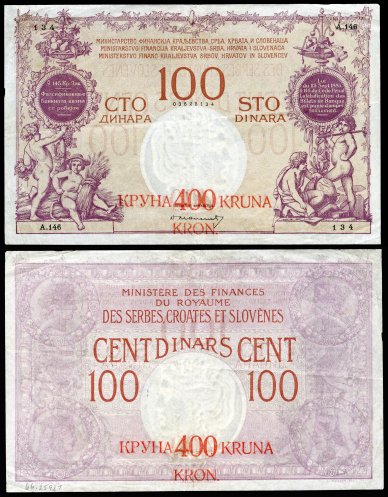
400 Kronen overstamped on a 100 Dinara note (1919)
The re-issue took place after the Kingdom got a new name of Yugoslavia. The newly designed banknotes were released in 1929 in denominations of 10 and 100 dinars. An additional issue of banknotes in denominations of 1,000 and 500 dinars occurred in 1931 and 1935.
From 1941 to 1944, the country was under the collaborationist government of Milan Nedic. The Serbian dinar was introduced with its peg to the reichsmark and the exchange rate of 1:1. Several types of coins were minted as well.
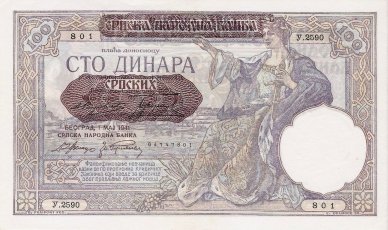
100 Serbian Dinara (1941)
In 1944, after the de-occupation of the Balkans, a new country called the Federal Republic of Yugoslavia was formed in place of the Kingdom of Yugoslavia. Though a new country existed only for a couple of months, it managed to issue its official currency in denominations from 1 to 1,000 dinars.
In 1946, the Federal People’s Republic of Yugoslavia emerged in the Balkan region and without delay introduced the banknotes in denominations from 50 to 1,000 dinars. Later, in 1950, the banknote in the largest denomination of 5,000 dinars was released. Besides, the country developed the mint of zinc and aluminum fractional coins of 50 para, 1 dinar, and 2 dinars. In 1955, they issued one more series of aluminum coins of 10, 20, and 50 dinars.
In 1963, when the country changed its name into the Socialist Federal Republic of Yugoslavia, the coins were minted with the full name on the reverse. The exception was only the fractional coin of 50 paras.
In 1966, the Yugoslavian money was printed in denominations from 5 to 100 dinars, and four years later the 500-dinar notes were released. In 1974, the government introduced the 20-dinar and 1,000-dinar notes.
Since 1965, two languages were used for the coin inscriptions, and in 1970, there were inscriptions already in four languages for denominations of 1, 2, 5, and 10 dinars. The other series were released in 1982, 1985, and 1988: the coins of 1, 2, 5, 10, 20, 50, and 100 dinars.
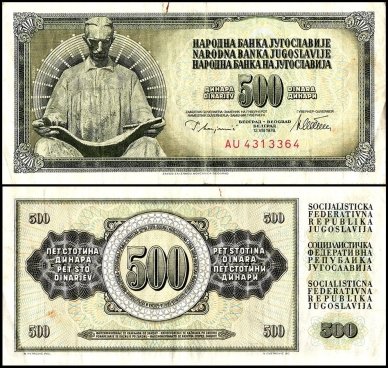
Yugoslavia 500 Dinara Banknote (1978)
Increasing inflation was the reason to start issuing large denominations - the coins from 10 to 100 dinars, and the banknotes of 5,000 dinars featuring the portrait of Josip Broz Tito (1985). Later, there were also the banknotes in denominations of 20,000, 50,000, 100,000, 500,000, 1 million, and 2 million dinars.
In 1990, the official currency of Yugoslavia was denominated for the reason of growing inflation in the background of the dissolution processes. The exchange rate was 1:10,000.
In 1994, the first series of new dinars appeared, but this did not deter the money of the dissolving country from inflation. If denomination took place only twice during the three previous years (in 1992 with the exchange rate of 1:10, and in 1993 - 1:1,000,000), there were two of them at once in 1994. The money devaluation was 1:1,000,000,000 and 1:10,000,000,000. During that time, almost all countries seceded from Yugoslavia except for Serbia and Montenegro.
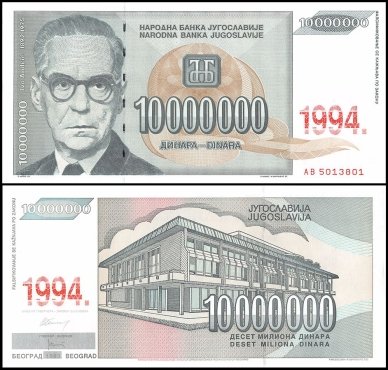
Yugoslavia 10 Million Dinara (1994)
As a result, the Macedonian denar was introduced in Macedonia, the Croatian kuna - in Croatia and Serbian Krajina, the euro - in Slovenia and Montenegro, the convertible mark - in Bosnia and Herzegovina and Republika Srpska.
The new Serbian dinar, pegged to the US dollar, continued its plunge but in a less prompt manner. Between 2006 and 2018, its exchange rate decreased from 60.5:1 to 104:1.
New Serbian Dinar Design
The currency is issued by the National Bank of Serbia. The notes in denominations of 10, 20, 50, 100, 200, 500, 1,000, 2,000 and 5,000 dinars are currently in circulation. The latest series was released in 2011 when the Serbs got the banknotes almost of the same design as of former Yogoslavia of the years 2000 and 2002.
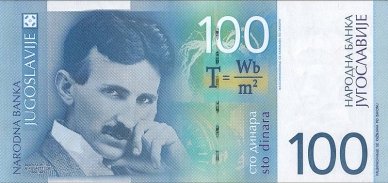
Banknote of 100 dinars with the portrait of Nikola Tesla
One Serbian dinar is divided into 100 kunas, but those coins were withdrawn from circulation long ago. Only dinars are used for payment transactions.
- 10 dinars is a yellow banknote that measures 131 mm by 62 mm. The obverse features the denomination and the portrait of the linguist Vuk Stefanović Karadžić, and the reverse - the denomination and his full-length portrait along with the letters of the Serbian alphabet.
- 20 dinars is a green banknote. It measures 135 mm by 65 mm and features the denomination and the portrait of Petar II Petrović-Njegoš (one of the country’s rulers) on the obverse and his mausoleum in the Lovćen National Park on the reverse.
- 50 dinars is a violet banknote that measures 139 mm by 66 mm. It depicts the denomination and the portrait of Stevan Stojanović Mokranjac on the obverse and the denomination and violin on the reverse.
- 100 dinars is a blue banknote that measures 143 mm by 68 mm. It features the Serbian legend and inventor Nikola Tesla on the obverse and one of his inventions on the reverse.
- 200 dinars is a brown banknote that measures 147 mm by 70 mm. It features the painter Nadežda Petrović on the obverse and the Gračanica Monastery on the reverse.
- 500 dinars is a light-green banknote that measures 147 mm by 70 mm. It features the portrait of the scientist Jovan Cvijić on the obverse and the Serbian national ornament on the reverse.
- 1,000 dinars is a red banknote that measures 151 mm by 72 mm. It features the portrait of the National Bank of Serbia Governor Đorđe Vajfert on the obverse and the Bank’s main building on the reverse.
- 2,000 dinars is a brown/grey banknote that measures 155 mm by 74 mm. It features Milutin Milanković on the obverse and one of his drawings on the reverse.
- 5,000 dinars is a purple/green banknote that features the portrait of Slobodan Jovanović on the obverse and the ornaments of the buildings of the Serbian Academy of Sciences and Parliament on the reverse.
The coins in denominations of 1-20 dinars circulate in the country as well. They are made of various alloys like steel, galvanic and plated copper, bronze.
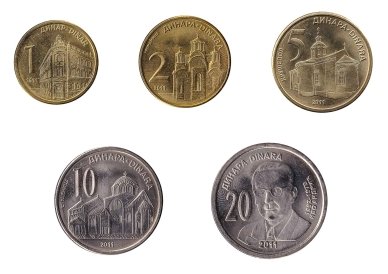
Serbian coins in denominations of 1-20 dinars
The obverse of the one-dinar coin features the image of the National Bank, the two-dinar coin depicts the Gračanica Monastery, and the five-dinar coin - the Krušedol Monastery. The ten-dinar coin has two variations: it depicts either the Studenica Monastery or the XXV Summer Universiade.
The coins in denomination of 20 dinars also have various designs and feature the portraits of Nikola Tesla, Milutin Milanković, Đorđe Vajfert, Ivo Andrić, and Mihajlo Pupin.
The Serbian Dinar in the World
Serbian currency has a fluctuating exchange rate that is determined by the inflation rate in the country. The Serbian dinar is not used in stock exchange transactions and is not suitable for manipulations connected with exchange rate differences.
FAQ
What is the name, symbol and abbreviation of the Serbian dinar?
The name of the Serbian currency is "Српски динар" (Serbian dinar) in Serbian Cyrillic script. The symbol for the Serbian dinar is "дин." (din). The commonly used abbreviation for the Serbian dinar is "RSD," which stands for "Republic of Serbia Dinar" in English.
What are the different types of Serbian dinar?
The Serbian dinar comes in banknotes and coins of various denominations, including 10, 20, 50, 100, 200, 500, 1,000, 2,000, and 5,000 dinars, as well as various para coins.
Who is depicted on the banknotes of the Serbian dinar?
Serbian dinar banknotes feature depictions of notable figures in Serbian history, culture, and science, such as Nikola Tesla, Mihajlo Pupin, and Vuk Stefanović Karadžić.
Is the Serbian dinar a stable currency?
The stability of the Serbian dinar can vary over time due to economic factors, but it has generally been relatively stable in recent years.
